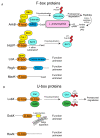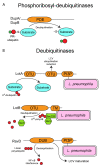Evolution and Adaptation of Legionella pneumophila to Manipulate the Ubiquitination Machinery of Its Amoebae and Mammalian Hosts
- PMID: 33467718
- PMCID: PMC7830128
- DOI: 10.3390/biom11010112
Evolution and Adaptation of Legionella pneumophila to Manipulate the Ubiquitination Machinery of Its Amoebae and Mammalian Hosts
Abstract
The ubiquitin pathway is highly conserved across the eukaryotic domain of life and plays an essential role in a plethora of cellular processes. It is not surprising that many intracellular bacterial pathogens often target the essential host ubiquitin pathway. The intracellular bacterial pathogen Legionella pneumophila injects into the host cell cytosol multiple classes of classical and novel ubiquitin-modifying enzymes that modulate diverse ubiquitin-related processes in the host cell. Most of these pathogen-injected proteins, designated as effectors, mimic known E3-ubiquitin ligases through harboring F-box or U-box domains. The classical F-box effector, AnkB targets host proteins for K48-linked polyubiquitination, which leads to excessive proteasomal degradation that is required to generate adequate supplies of amino acids for metabolism of the pathogen. In contrast, the SidC and SdcA effectors share no structural similarity to known eukaryotic ligases despite having E3-ubiquitin ligase activity, suggesting that the number of E3-ligases in eukaryotes is under-represented. L. pneumophila also injects into the host many novel ubiquitin-modifying enzymes, which are the SidE family of effectors that catalyze phosphoribosyl-ubiquitination of serine residue of target proteins, independently of the canonical E1-2-3 enzymatic cascade. Interestingly, the environmental bacterium, L. pneumophila, has evolved within a diverse range of amoebal species, which serve as the natural hosts, while accidental transmission through contaminated aerosols can cause pneumonia in humans. Therefore, it is likely that the novel ubiquitin-modifying enzymes of L. pneumophila were acquired by the pathogen through interkingdom gene transfer from the diverse natural amoebal hosts. Furthermore, conservation of the ubiquitin pathway across eukaryotes has enabled these novel ubiquitin-modifying enzymes to function similarly in mammalian cells. Studies on the biological functions of these effectors are likely to reveal further novel ubiquitin biology and shed further lights on the evolution of ubiquitin.
Keywords: Dot/Icm; E1/2-independent ubiquitin ligase; E3-ubiquitin ligase; F-box; SNL E3-ligase; U-box; amoebae; deubiquitinase; effectors; evolution; legionella pneumophila; ubiquitin.
Conflict of interest statement
No potential conflicts of interest were reported by the authors.
Figures



Similar articles
-
Ubiquitination of Sec22b by a novel Legionella pneumophila ubiquitin E3 ligase.mBio. 2023 Dec 19;14(6):e0238223. doi: 10.1128/mbio.02382-23. Epub 2023 Oct 26. mBio. 2023. PMID: 37882795 Free PMC article.
-
Bacterial ubiquitin ligases hijack the host deubiquitinase OTUB1 to inhibit MTORC1 signaling and promote autophagy.Autophagy. 2024 Sep;20(9):1968-1983. doi: 10.1080/15548627.2024.2353492. Epub 2024 May 31. Autophagy. 2024. PMID: 38818749 Free PMC article.
-
The Legionella pneumophila F-box protein Lpp2082 (AnkB) modulates ubiquitination of the host protein parvin B and promotes intracellular replication.Cell Microbiol. 2010 Sep 1;12(9):1272-91. doi: 10.1111/j.1462-5822.2010.01467.x. Epub 2010 Mar 25. Cell Microbiol. 2010. PMID: 20345489
-
Cellular microbiology and molecular ecology of Legionella-amoeba interaction.Virulence. 2013 May 15;4(4):307-14. doi: 10.4161/viru.24290. Epub 2013 Mar 27. Virulence. 2013. PMID: 23535283 Free PMC article. Review.
-
Divergence of Legionella Effectors Reversing Conventional and Unconventional Ubiquitination.Front Cell Infect Microbiol. 2020 Aug 21;10:448. doi: 10.3389/fcimb.2020.00448. eCollection 2020. Front Cell Infect Microbiol. 2020. PMID: 32974222 Free PMC article. Review.
Cited by
-
Glycosylating Effectors of Legionella pneumophila: Finding the Sweet Spots for Host Cell Subversion.Biomolecules. 2022 Feb 4;12(2):255. doi: 10.3390/biom12020255. Biomolecules. 2022. PMID: 35204756 Free PMC article. Review.
-
Antibiotic susceptibility situation of environmental Legionella pneumophila isolates in Southern Germany.J Water Health. 2024 Dec;22(12):2414-2422. doi: 10.2166/wh.2024.490. Epub 2024 Nov 26. J Water Health. 2024. PMID: 39733365
-
Editorial: Bacterial Effectors as Drivers of Human Disease: Models, Methods, Mechanisms.Front Cell Infect Microbiol. 2021 Jul 8;11:708228. doi: 10.3389/fcimb.2021.708228. eCollection 2021. Front Cell Infect Microbiol. 2021. PMID: 34307200 Free PMC article. No abstract available.
-
Functional Characterization of Non-Ankyrin Repeat Domains of Orientia tsutsugamushi Ank Effectors Reveals Their Importance for Molecular Pathogenesis.Infect Immun. 2022 May 19;90(5):e0062821. doi: 10.1128/iai.00628-21. Epub 2022 Apr 18. Infect Immun. 2022. PMID: 35435726 Free PMC article.
-
Host-bacteria interactions: ecological and evolutionary insights from ancient, professional endosymbionts.FEMS Microbiol Rev. 2024 Jun 20;48(4):fuae021. doi: 10.1093/femsre/fuae021. FEMS Microbiol Rev. 2024. PMID: 39081075 Free PMC article. Review.
References
Publication types
MeSH terms
Grants and funding
LinkOut - more resources
Full Text Sources
Other Literature Sources
Miscellaneous

